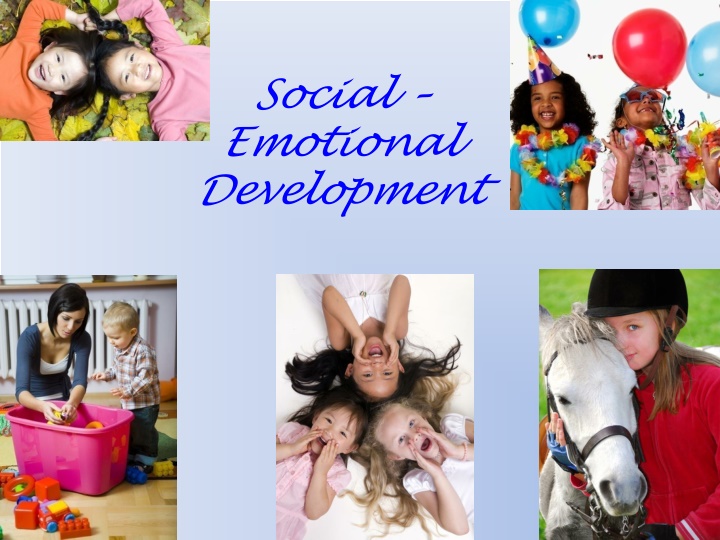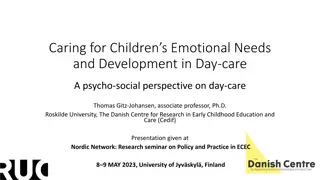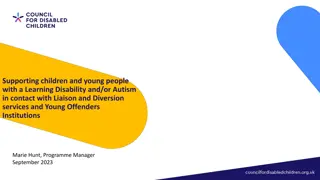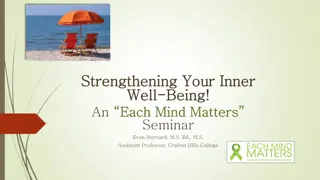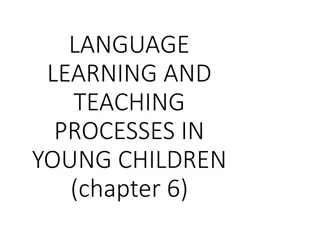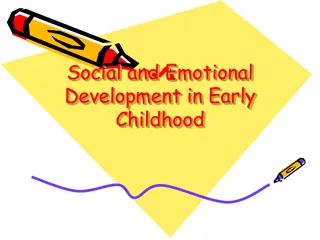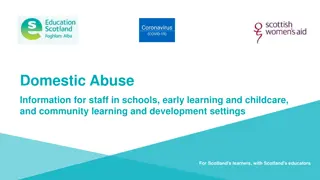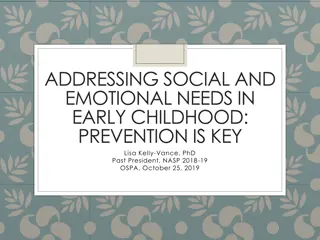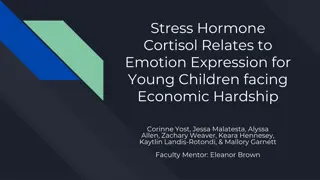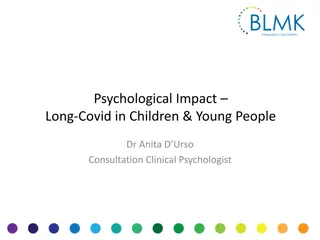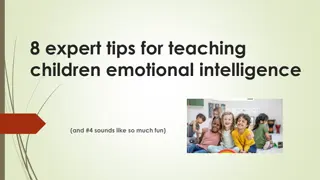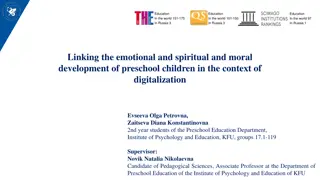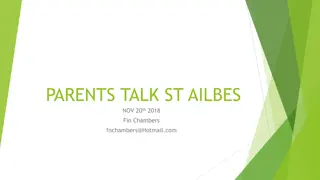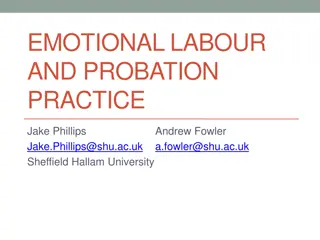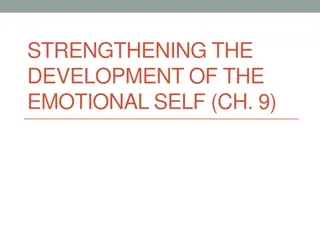Social and Emotional Development in Young Children
Explore the general emotional patterns and specific emotions in young children aged 4 to 6 years. Understand the positive and negative characteristics such as self-centeredness, independence, anxiety, and fear, and learn how to deal with common fears like imaginary dangers and separation anxiety. Recognize the importance of parental approval, independence, and emotional expression in nurturing healthy social and emotional development.
Download Presentation

Please find below an Image/Link to download the presentation.
The content on the website is provided AS IS for your information and personal use only. It may not be sold, licensed, or shared on other websites without obtaining consent from the author.If you encounter any issues during the download, it is possible that the publisher has removed the file from their server.
You are allowed to download the files provided on this website for personal or commercial use, subject to the condition that they are used lawfully. All files are the property of their respective owners.
The content on the website is provided AS IS for your information and personal use only. It may not be sold, licensed, or shared on other websites without obtaining consent from the author.
E N D
Presentation Transcript
Social Emotional Development
General Emotional Patterns General Emotional Patterns 4 4- -6 year olds: 6 year olds: Meet new people = can change behaviors More responsibility = greater independence 4 year olds 4 year olds Negative: Negative: Self-centered Impatient Defiant NO Bossy Turn on a dime Name-calling, making fun or playing with someone s name sounds Positive: ositive: * Loving and affectionate * Want parental approval * Like to make people laugh * Trying to be independent
General Emotional Patterns General Emotional Patterns - continued continued 5 year olds (Positive): 5 year olds (Positive): Practical Sympathetic Mindful of parents/teachers Conform to rules easily -- Serious -- Conscientious -- More realistic (Negative): (Negative): Anxious Can be too eager to please
General Emotional Patterns General Emotional Patterns cont. 6 year olds (Positive): 6 year olds (Positive): Appreciate humor more Stronger emotions Crave praise (Negative): (Negative): Stubborn Quarrelsome, argumentative Rapidly changing moods, again Know-it-all , resent directions Easily hurt and discouraged
Specific Emotions Specific Emotions Fear THE MOST COMMON EMOTION IN YOUNG CHILDREN THE MOST COMMON EMOTION IN YOUNG CHILDREN Well Well- -developed imagination developed imagination imaginary dangers Ghosts, robbers, monsters, kidnappers, vampires Ghosts, robbers, monsters, kidnappers, vampires Children may also fear school Children may also fear school afraid to leave security of home/family. home/family. Being abandoned by caregiver Being abandoned by caregiver if mommy leaves, she won t come back she won t come back Fear imaginary dangers afraid to leave security of if mommy leaves, How to deal: How to deal: Accept the fear Accept the fear it s very real for the child it s very real for the child Listen without ridicule Listen without ridicule Children need to trust you Face the fear Face the fear practice the situation before it happens. practice the situation before it happens. Pet a toy dog before the real thing Pet a toy dog before the real thing Look under the bed/in the closet in daylight before doing it at Look under the bed/in the closet in daylight before doing it at night. night. Children need to trust you
Specific Emotions Specific Emotions Anger Anger usually comes from difficulties with friends or not having usually comes from difficulties with friends or not having the ability to do something the ability to do something At 4 At 4: Show physically, lasts longer, may threaten others to get even At 5 At 5: Want to hurt feelings of others more than physical hurt. At 6 At 6: Tease, insult, nag, make fun more wordy
Specific Emotions Specific Emotions How to deal with anger: How to deal with anger: More social interactions More social interactions Practice social situations Practice social situations Accept that things belong to others, not just Accept that things belong to others, not just themselves themselves Teach respect for others belongings Teach respect for others belongings Set an example Set an example Encourage use of words Encourage use of words
Specific Specific Emotions cont. Jealousy Jealousy Sibling rivalry Very common Tattling on sibling Comparisons are rarely helpful, often hurtful to a child How to deal: How to deal: Don t compare children at home or in the classroom Teach empathy A little extra attention, for each child, separately is good, have a special activity for different children
Stress Stress Stress is everywhere for every age!!! Learn to look for signs of stress: Nail-biting --Trouble sleeping Moodiness --Trouble in school Headaches --Pulling away/Being clingy Any difference in child s behavioral pattern Hug, listen, teach/model how to handle stress Find the cause of the stress Teach ways to relieve stress Maintain normal limits on behaviors. --Read a book about stress --Follow up on children
General Emotional General Emotional Patterns 7 Patterns 7- -12 year olds: 12 year olds: Developing a sense of self: Developing a sense of self: See themselves as a mixture of traits and qualities Can recognize own skills and abilities. Realize they behave differently in different situations. Point of view - different Gender Identity: Gender Identity: Differences between being a boy or girl. Role models. Interest in opposite sex
Middle Childhood Middle Childhood Emotional Changes Emotional Changes overview Age 7: Age 7: withdrawn, quiet, worry-warts sensitive, prefer to be near home Age 8: Age 8: more outgoing, want to explore, dramatic, lively, positive view, tend to exaggerate Age 9: Age 9: harsh toward self and failing, tense, concentrated Age 10: Age 10: positive, happy, enjoying everything
Middle Childhood Middle Childhood Emotional Changes Emotional Changes continued Early Adolescence Early Adolescence: HORMONES!!!!!!!!!!!! Puberty sends hormones into overdrive Mood swings look out, they re quick and intense Self-absorbed pay attention to self and peers Often hide true feelings seem not to care Emotional control is developing somewhat
Middle Childhood Middle Childhood Specific Emotions Specific Emotions Anger: Anger: Boil over and fade quickly usually peer related Anger action is usually not reacting to immediate situation, but something prior How to Handle: How to Handle: Can use words much better to express problems - encourage Set a good example - best way to teach how to handle anger and frustration Model handling without ANY violence or physical action Rewards can be appropriate to help train defeats intrinsic motivation development
Middle Childhood Middle Childhood Specific Emotions Specific Emotions cont. Fear & Worry: Fear & Worry: Fears still exist, may interfere with sleep New worries show up, more severe/realistic that the dark car accidents, death Usually in response to what happens in family or peer group Concern for how others/peers view them
Living with children 7 Living with children 7- -12 12 4 helpful hints for dealing with children in this age are: 1. Be Patient!! Be Patient!! this is a difficult time, they need to learn how to deal with all the changes. 2. Don t take it personally Don t take it personally It s a phase, it will pass, they don t usually mean what they say. 3. Keep the child under control Keep the child under control Don t allow for inappropriate behavior, explain what s appropriate 4. LISTEN LISTEN Kids usually want to talk, let them, it doesn t mean you agree with them, but show how to handle it.
Social and Moral Development 7 Social and Moral Development 7- -12 12 Children value friends who are loyal, comfortable, and fun Puberty affects friendships kids want to talk to kids Relate deeper to others empathy Tend to keep more friends of the same gender, even though they may be interested in the opposite gender
Social and Moral Development 7 Social and Moral Development 7- -12 continued 12 Number of friends varies, no right number Do you have the friendships you WANT to have? Do you value yourself by the NUMBER of friends you have? Peer Pressure Peer Pressure adopting words, behaviors, habits of peer group to fit in Can be VERY powerful, both positively and negatively. Conformity adopting words, behaviors, habits of peer group to fit in, avoid ridicule Joking, teasing very hurtful, damaging
Social and Moral Development 7 Social and Moral Development 7- -12 continued 12 Family relationships change and grow Family time, rules and boundaries are still needed Changes in feelings toward parents: 7s depend on parents, but challenge parents rules 8s cling to parents 9s self-centered, ignore parents more 10s usually smooth-sailing 11/12s can be critical, more questioning and development of thought 12s more cooperative Late teens usually return to respecting parents, understanding why rules are important
Social and Moral Development 7 Social and Moral Development 7- -12 continued 12 Moral Development Moral Development: Observe morals of others and have to start to decide more for themselves Set good examples of moral behavior: Do as I say AND do do Support a child s conscious development inner Jimminy Cricket Discuss possible situations/outcomes include examples for your past Reinforce and model empathy how would you feel if that happened to you??? Fairness matters use that to explain situations
